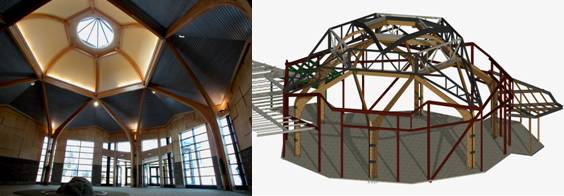Boston, May 14, 2008 – This month, a new memorial centre uniquely designed to accommodate the diverse faiths of an entire nation opens at Beechwood, the home of the national cemetery of the Canadian armed forces.
The Beechwood National Memorial Centre is a circular hall designed with input from the major faith groups in Canada to ensure that appropriate symbolism in the architecture could apply to all. The space can be configured for remembrance rituals and traditions of all types, while not privileging one faith over another.

Designed in Archicad by Ottawa-based Robertson Martin Architects, the National Memorial Centre is the new crown jewel in Beechwood’s 160 acres of stunning landscaping. It includes reception rooms and support spaces sized to suit different scales of memorial and cultural events. These rooms open on to a central courtyard which lights the rooms and contains plantings to mark the changing seasons.
The National Historic Site rests on a ledge of rock of the same geological formation and at the same elevation as Canada’s Parliamentary precinct. The design seeks to contrast the ‘groundedness’ of rock and its connotations of permanence, juxtaposed with the transience of nature and the seasons.
For the circular memorial hall, deriving design inspiration from nature and geometry, expressions of ‘branching trees’ and ‘upswept arms’ support a central oculus; the light passing from above marks the passage of time in both smaller and longer time intervals as it passes over the interior textures and finishes of stepped wood panels, skeletal framing and rough stone walls. A rock, selected from the grounds of Beechwood, anchors the space and provides a focal point.
In its role as Canada’s National Military Cemetery, complementing the memorial space is a large reception hall with an adjacent ‘Hall of Colors’ to display the laid-up colors of Canada’s military regiments. This hall features a stained-glass window designed by and for military chaplains of all faiths to honor those members of the Forces who have served their country.
According to architect Robert Martin, using a 3D Archicad model proved invaluable for facilitating discussions among the owner, consultant, contractor, trade teams and faith group leaders. “In addition to engaging all the stakeholders in the design process from the earliest stages, it allowed for value-engineering of design intent within budgeted means at later phases of the project,” he said. “The Archicad BIM model has lessened construction and risk pricing and was an invaluable communication tool throughout the process. For example, there was concern about sequence of construction for the glue-laminated members and allowable clearances for hoisting. A meeting with the design team allowed a real-time manipulation of the structure to alleviate these concerns.”